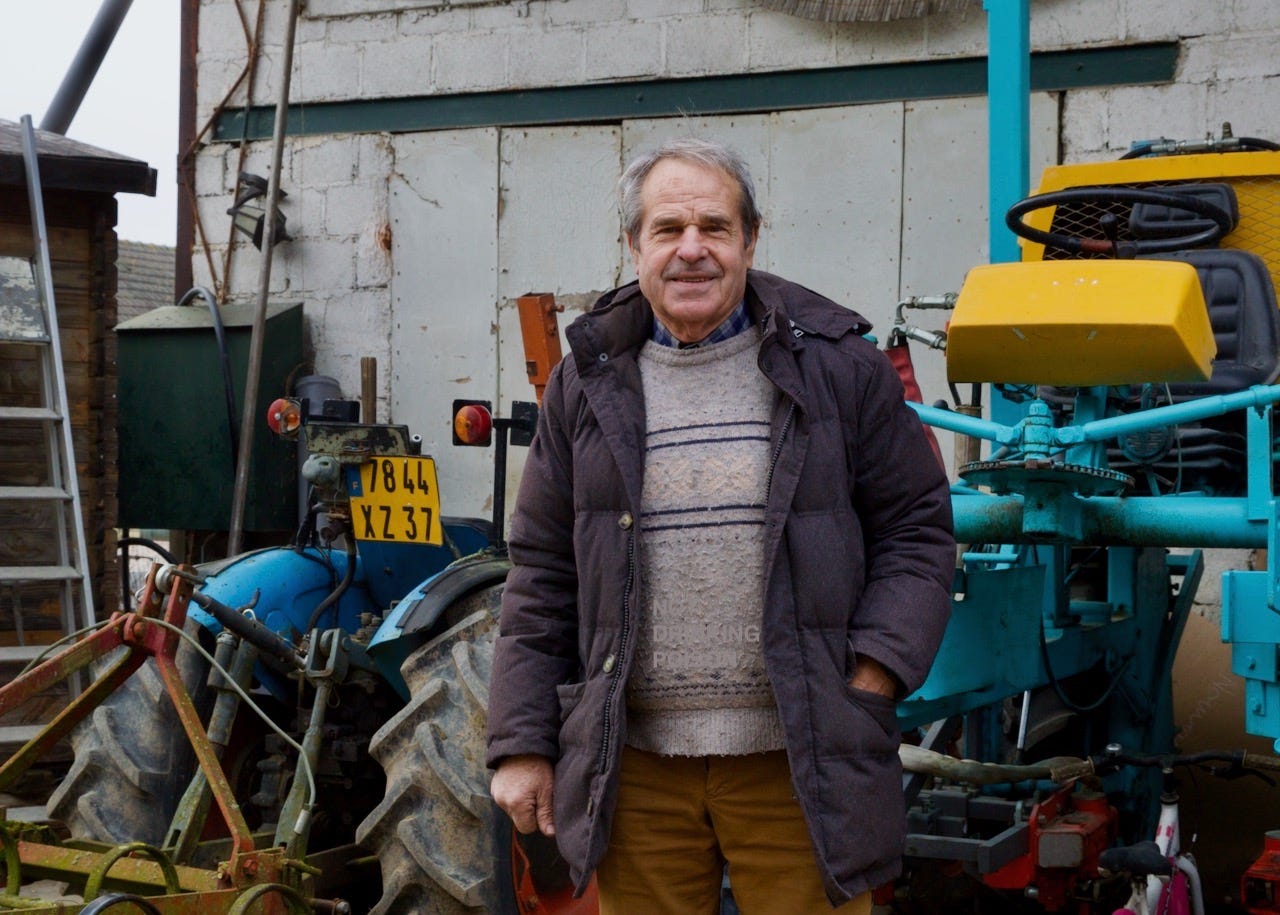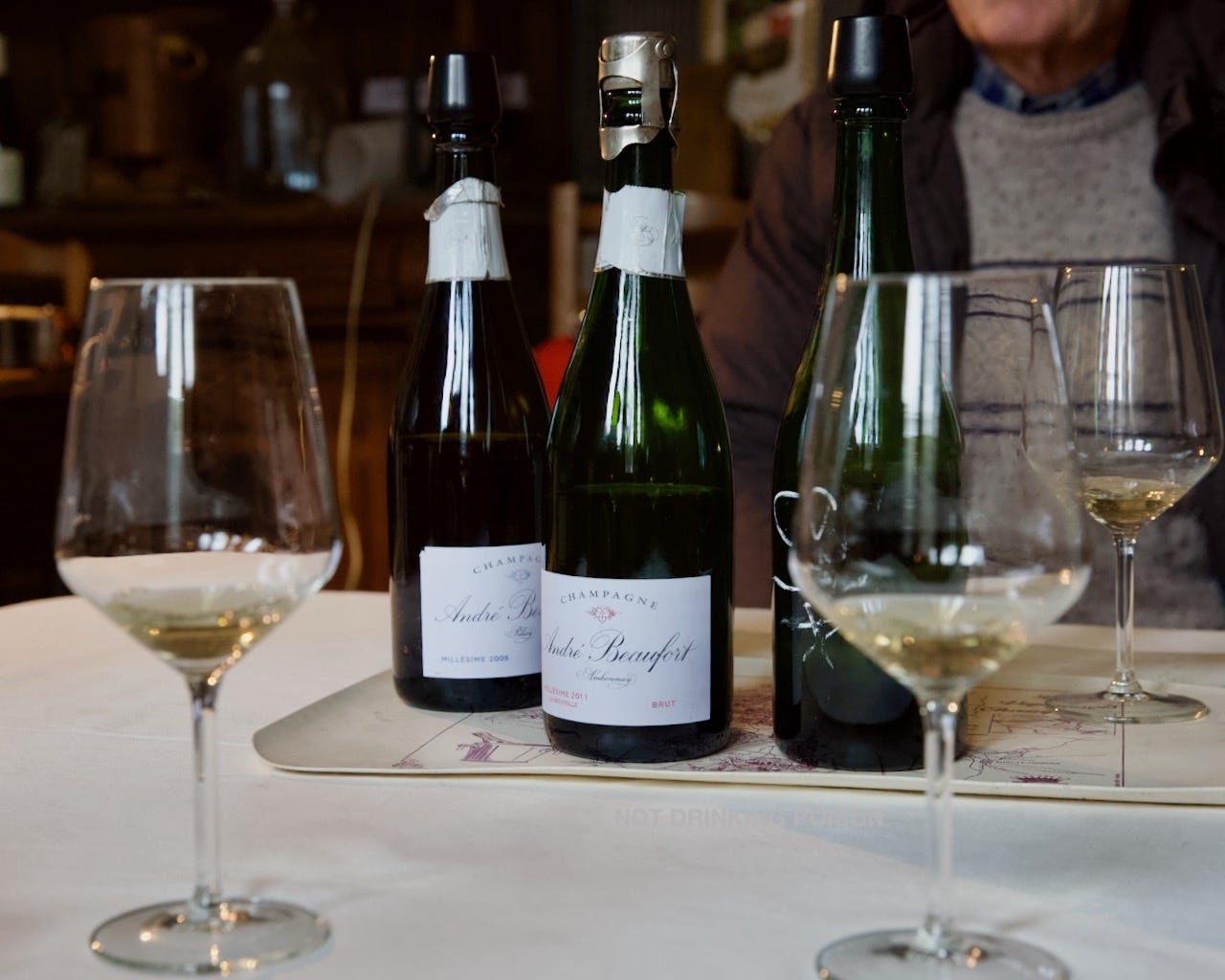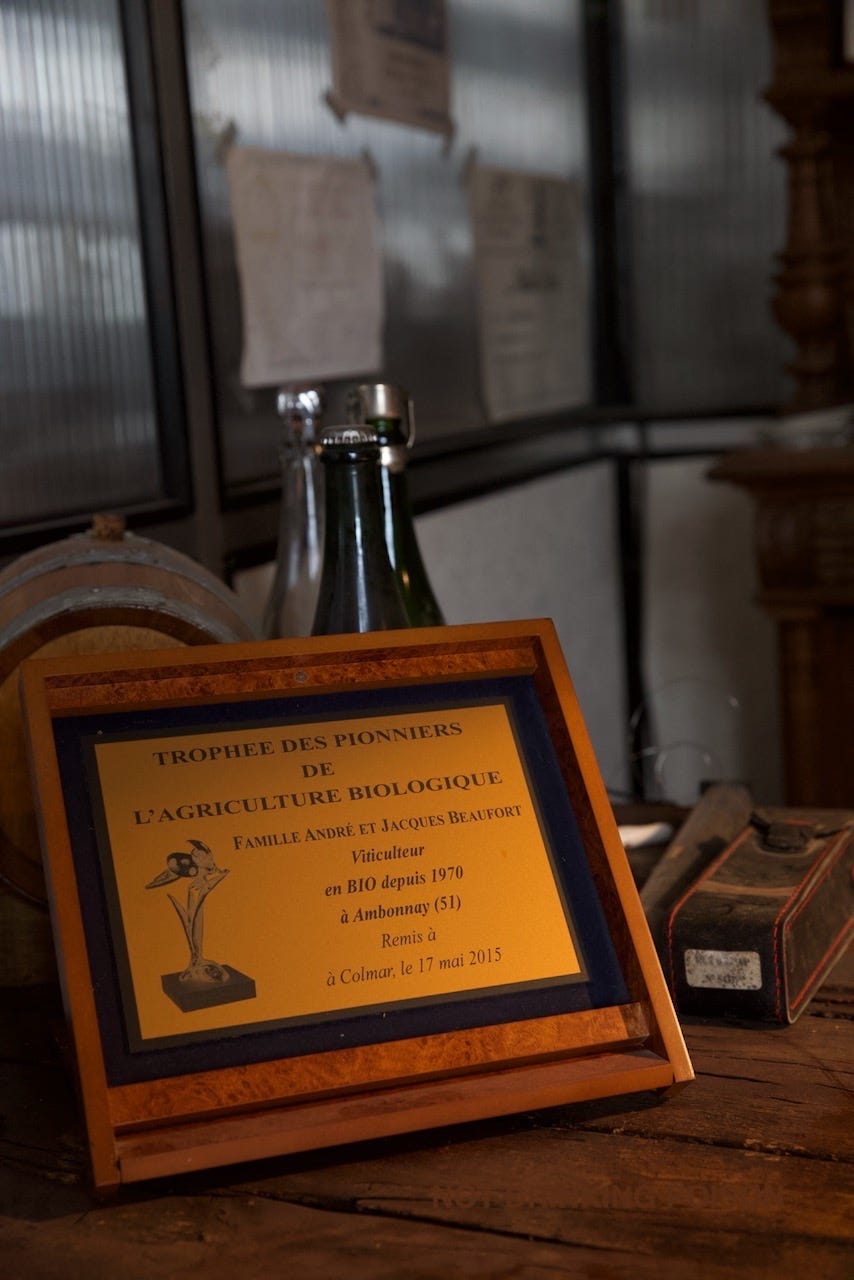The Legends of Champagne André Beaufort
A chat with Champagne organics pioneer Jacques Beaufort.

Among the most lauded and divisive of Champagne estates working in a natural style, Champagne André Beaufort is split between 1.6ha in Ambonnay and 6.2ha three hours’ drive away in Polisy. Estate patriarch Jacques Beaufort ceased employing synthetic chemicals in agriculture as far back as 1970, and soon became an early proponent of the use of essential oils in vineyard treatments. Today he has mostly retired and resides in Ambonnay, while two of his sons, Constant and Réol, run the estate’s day-to-day duties. (Beaufort has eight children, most of them vignerons, making succession at Champagne André Beaufort a complicated affair. His son Amaury Beaufort was the most recent to leave the estate, splitting off in 2018 to produce his own stellar champagne.)
In my experience, André Beaufort champagnes are generally known for relatively high dosage, relatively high prices, and what conventional champagne tasters are apt to call “inconsistency.” (That which any natural wine aficionado would know simply as “fidelity to the vintage.”) Those who take a closer interest in the estate know it for its very long sur lattes aging, its minimal employ of sulfites in vinification, and its use of native yeasts in secondary fermentation (on which more below).
I spent over a year trying, and failing, to arrange an appointment with the estate as part of research for my chapter on Champagne in my forthcoming book. As I last resort, I called Jacques Beaufort directly in mid-January, and was delighted when he agreed to meet.
Quick Facts
Champagne André Beaufort comprises 7.8ha, spread between 1.6ha in Ambonnay and 6.2ha in Polisy.
As of 2018, the estate is run by Constant and Réol Beaufort.
The estate has practiced organic agriculture since 1970 (before the advent of official French organics legislation in 1981). Jacques Beaufort resisted paying for official certification until 1994.
Musts ferment on native yeasts and without prevention of malolactic fermentation. Clay fining is occasionally practiced before bottling before secondary fermentation.
The estate famously conducts its prise de mousse with native yeasts. What this means, in concrete terms, is the laborious creation and strict oversight of series of starter ferments before each bottling, employing must in which sugar remains. (The inference, which must for Champagne legality reasons remain no more than an inference, is that this must comes from a successive vintage.) The starter ferments are analyzed and those that are healthy are used in conjunction with concentrated rectified must (MCR) to initiate secondary fermentation.
This practice is vanishingly rare among even the natural-oriented Champagne estates. Amaury Beaufort does it. David Léclapart did it for two vintages. Many others have experimented with it, and gone back to using exogenous yeast.
It is often repeated that Champagne André Beaufort employs no sulfur in vineyard treatments. This is essentially true for its parcels in Ambonnay (more below), but not true for most of the rest of the estate’s holdings.
It is also often repeated that Champagne André Beaufort employs no sulfites in vinification. While during his career Jacques Beaufort produced many, but not all, champagnes without sulfite addition save a micro-dose at press, his sons now employ a dosage of 30mg/L at disgorgement.
For what it’s worth, Champagne André Beaufort is curiously absent from Champagne critic Peter Liem’s masterful book on the region.
JACQUES BEAUFORT: AN INTERVIEW
This interview was conducted in mid-January 2022. It has been condensed and edited for clarity.
What made you decide to cease using synthetic chemicals back in 1969?
I had a brother who was a representative of ESSO products. They had an agricultural department. And at first I tried all the latest ones that were released from the factories. Then I got allergies in 1969. I perceived that I could no longer tolerate working in vines with chemical products.
In the autumn, each time I ate an apple, I had allergies. I got cold sores in the mouth. Around then I met my wife in the Ardennes, quite far from here. I went to see her often on Sundays, and she gave me apples. With the ones I ate at her house, I was fine, no allergies.
I realized that it was the products they were putting on the apple orchards here, like on the vineyards, that provoked my allergies. So for me it was an alarm bell. In 1970, I got rid of all the chemical products.
But the estate was certified much later, in 1994?
At the start, I did Lemaire-Boucher method. We worked a lot with aromatherapy, with seaweed preparations. Then [with the passage of organics legislation in France] in 1981, you had to be certified. You have to pay to prove you were in organic agriculture.
We polluted much less than others, and we harvested less than the others, and we had to pay. I wasn’t in agreement. I was one of the few, along with Bannwarth in Alsace, who said we didn’t want to pay for certification.
And so the DGCCRF came, and said, “You have to pay.” They registered me as in conversion in 1994. But I was already organic.
To be organic, does one need to use organic concentrated must for the prise de mousse?
There is a percentage of tolerance, for the appellation approval. Because we couldn’t find it. We couldn’t even find organic sugar, at the start. We had guarantees on certain things, there wasn’t this or that in the sugar, but it wasn’t certified organic. But that’s at the start, back in the 1970s and 1980s.
But now I find people are pushing the limits, in terms of the approved methods of organic farming. Because certain products that I always forbade myself from using are accepted in organics now.
Like organic insecticides?
Now it’s become a business of organics. It’s a shame. Because we lost the idea, the spirit, the respect of the idea. Now I perceive that anything goes.
Consumer perceptions of organics have also changed a lot.
At the start, in the 1970s, 1980s, up until the 1990s, I’d tell people who came here that we’re in organic agriculture. And people were in a hurry to leave! They didn’t understand at all. It was just a word. They thought I added a lot of products. And the government, the governing bodies, were complicit, because they hid the truth.
I used to put on the labels, “Vines cultivated without chemical fertilizers,” etc. In 1976 I had a big boss from the DGCCRF who said, “Monsieur Beaufort, you don’t have the right to put that on the label. It’s a counter-truth.”
I said, “I put exactly what I do and what I don’t do.”
And he said, “Well, it implies that the others they add products.”
I said, “If you forbid me to put this, you should oblige all the other colleagues to list what they put on their vines.”
He told me, “The label would never be big enough to fit all that we put in the vines and in the wine.”
I said, “Well, if you exonerate the others, I’ll continue put this on my label.”
And he said, “Well, if it’s like that, then as of tomorrow I’ll put two agents on your back.”
So I had the DGCCRF on me continually. The Comité Champagne, the INAO, the syndicat of vignerons, all against me. I had a huge dossier.
In 1999, the DGCCRF and the INAO, they came in the vines. Without saying anything. They gave me a report. It said, “Vines not well trained.” Because I had left the apexes. Because the vintage was apt for it, to have a lot of branches, and good maturity. They said, “Leaves attacked by mildew.” I had a few stains of mildew, but the grapes, were very healthy. And they cited, “Presence of grass”! Presence of grass in my vines.
The following year, they took away my plantation rights. They stole money from me, that I’d set aside, and they didn’t give me the planting rights.
Nowadays, of course, they insist that vignerons grass over at least one parcel.
Your Champagnes, famously, see secondary fermentation on native yeast, which helps explain their unique personality. Have you had difficulty receiving the appellation approval at times?
I have a lot of trouble to get my champagnes approved. They target me. Because all good qualities, for them, are faults. There are too many aromas! And they don’t like aromas.
I had a bottling of ten-thousand bottles refused, because they said there was volatility. I had a Swiss friend, who worked in the laboratories. I gave him a bottle, and they said, “Monsieur Beaufort, you could have three times that acidity, and it wouldn’t be perceptible.” But the expert Champagne tasters, they felt it.
So we sent it to another lab in France, and got the same result. And I knew someone near Colmar, who worked in a lab where they analyze olfactory elements. They gave me a report, the same result. So how did this happen? Three labs cannot find it? But the tasters in Champagne find it. Something that doesn’t exist.
In your estimation, has organic viticulture affected how your wines age?
Between 1966 and 1969, when we did chemical treatments, the wines aged very poorly. But since I’m in organics, the wines don’t seem to age. They stay young. And there are certain years where I don’t add SO2, and it still holds up.
There were very bad years for other estates, and people don’t find them bad with our champagnes. Even bad years, like 2001, 1987, even 1994. It’s a shame I haven’t kept any 1972, because that’s the worst year in Champagne, and my wine was very precise.
Your work is unusual among Champagne producers working in a natural style, in that your champagnes tend to see dosage.
I have champagnes that have a lot of body. Most of the time, when I add sugar, you practically don’t sense it. It absorbs well. I find that sugar is a flavor enhancer. So it reveals aromas that are hidden in the wine. It’s not make-up or a façade.
The champagnes they found on a sunken boat in the North Sea, they were dosed at 100g/L. More than 100g/L. But these were wines that weren’t treated with products like today. Now we have falsified everything with chemical products.
How so?
I read a study on the effects of synthetic chemical molecules on vegetation. Researchers found that synthetic chemical molecules are like an asphalt, or a barrier, around the aromatic cells of plants.
They found that many plants are on their way to extinction. Because synthetic chemical molecules cause plants and flowers to lose their perfumes. And since they lose their perfumes, they can’t attracts insects to fertilize them. It no longer interests the insects, and it’s the insects that do the work. So the plants themselves die.
I’ m skipping a lot of steps here, but basically, if I don’t use synthetic chemical molecules in the vines, the vines’ aromatic cells communicate from the end of the root to the extremity of the vine growth. So that’s where you find the perfumes: of terroir, of the variety, and of the weather…
Long ago, there was a representative of Lemaire-Boucher who came often in the vines at the moment of harvest. And he’d say, “Oh, taste that ! Taste that!”
For me, it was just grapes ! But now I realize he was right, fifty years ago. He had found that when I didn’t apply copper or sulfur, I had much more aromas.
On the internet it’s often written that you’ve eliminated sulfur treatments even in the vineyards. Is that true?
The last sulfur treatment I did on the vines in Ambonnay was in 1993. But the children put some on in 2019, because I was in the hospital. I wasn’t happy. They didn’t have confidence, and they didn’t quite know…
Otherwise, there are other vineyards where I started even before 1973 to eliminate sulfur treatments. I haven’t yet managed to entirely eliminate copper.
Otherwise, I haven’t put on insecticides, even natural ones, in the last thirty-five or forty years. And no pheromone traps! There are a lot of people in organics that use pheromones, and I’m not in agreement. It’s not good. They’re toxic products. They write that pregnant women can’t distribute them. They prevent pregnant women from applying them, but if a pregnant woman goes in the vines, she’ll still breathe in the pheromones. So it’s not logical.
FIN
Champagne André Beaufort
1 Rue de Vaudemanges
51150 AMBONNAY
FURTHER READING
A July 2021 visit to Jacques Beaufort’s son Amaury Beaufort in Bar-sur-Seine.






Hey Aaron, I didn’t realise that he was so “extremely radical” and had so much problems with “officials”. I visited him once in Ambonnay. Today, we drink his 1996, 2004 and 2008 champagnes and these are really great wines (1996 from Selosse is also really great, but totally different), but the ones from Ambonnay stand out…. Personally, I would have added a bit less dosage. By the way, my wife and I visited Anselme Selosse during 20 years..!